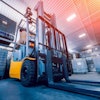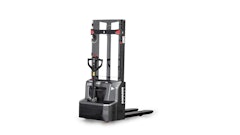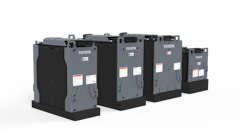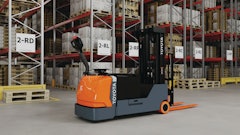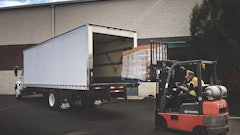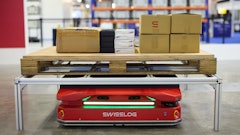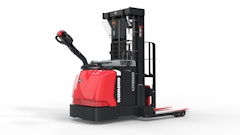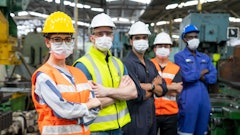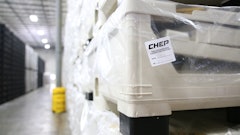
PAS Americas is rethinking warehouse automation with a new line of solutions.
PAS Americas is a new material handling company backed by years of experience. Based in Rolling Meadows, IL, PAS designs high-density automated and semi-automated storage systems.
The company was formed this past June when Power Automation Systems, a California-based engineering company that specializes in automated storage and retrieval systems, formed a joint venture with Konstant Inc., Rolling Meadows, IL, a racking systems specialist that has been manufacturing the Pallet Runner for the last 10 years.
“PAS Americas is manufacturing and marketing a full line of automated and semi-automated equipment that’s unique to the marketplace,” says Steve Dale, sales manager for Pallet Runner.
“These solutions are effective alternatives to the traditionally offered AS/RS, and they are highly flexible—we can work around obstacles in a facility. They are designed in modules and offer adaptability in layout and configuration, simple control systems and easy maintenance, the ability to add capacity as needed and increase throughput performance.
“That’s been one of the huge advantages of the Pallet Runner,” adds Dale. In addition to the Pallet Runner, the company now offers PowerStor for automated pallet storage and retrieval, PowerBuild for automated layer picking and PowerStage for automated transportation and order staging.
The Pallet Runner system is a high-density semi-automated storage system that enables the storage of multiple pallets in a deep lane configuration. The system enables pallets to be retrieved from any lane with multiple SKU locations. It can be used with an existing lift truck fleet and can be installed in any number of configurations to fit a facility’s structure.
Pallet Runner is suitable for a number of applications, including case picking, first-in first out (FIFO) and last-in first out (LIFO), as well as any picking system maintaining the 80/20 rule (20 percent of SKUs represent 80 percent of volume).
Plus, it is ideal for freezer applications.
PowerStor is a pallet handling system that provides the capability for the rapid staging and storing of large quantities of any size pallet in a small space. The system runs on vertical lifts, as opposed to cranes, making it less expensive and more flexible than a crane system. Features include:
- Easily configurable—handles any number of levels; any number of pallets in a row—short or long—can be different on each side of the aisle;
- Provides unparalleled cube utilization;
- Unlimited throughput capabilities;
- Simple to operate—redundancy of components prevents any downtime that impacts business operations
- It can work in a low-ceiling facility or buildings that have stepped, curved or sloped ceilings.
PowerBuild is a high-speed mixed palletizing system that can produce up to 12 different pallets/orders simultaneously and fulfill customer-specific orders. The system consists of a palletizing robot fixed to a rail-driven cart. Like the PowerStor, the system is flexible in layout and configuration options. PowerStage, which works in conjunction with PowerStor and PowerBuild, is a flexible, high speed pallet staging system.
To run these systems, PAS offers PASWare, a custom-built software program that can be easily integrated into any existing warehouse management systems as well as legacy systems.
Dale points out that not only are these solutions economically sensible, but environmentally sound as well. “Our solutions help our clients to reduce labor costs, operating costs and emissions, as well as enable them to operate a more environmentally-friendly company.”
After multiple installations within Europe, PAS-Americas is now embarking on its first North American installation to commence in early 2011.
The Sky’s The Limit
High-rise warehousing is a viable alternative to conventional storage.
By Mike Netting
More and more companies are turning to high-rise storage solutions, and the Automated Storage/Retrieval Systems (AS/RS) utilized within them, to increase distribution efficiency and control, decrease energy use, reduce labor costs and maximize use of available land.
With numerous advantages, high-rise warehousing can provide an alternative to conventional warehousing.
Conventional Vs. High-Rise
When compared to conventional steel-frame warehousing, high-rise warehousing differs in many ways. A conventional warehouse has a steel frame as its structure and is composed of insulated metal wall panels, prefabricated metal walls or tilt-up walls.
High-rise warehouses typically are rack-supported buildings. In rack-supported structures, the racking system comprises the primary structural support for the facility, including its roof and walls, which are often called its “skin.”
Conventional warehouses have product storage heights of 40 to 60 feet, must be expanded horizontally and rely on workers and forklifts to move products. High-rise warehouses can be constructed as high as 140 feet, resulting in an increased product storage density and requiring much less real estate.
High-rise warehouses also are outfitted with automated storage and retrieval systems (AS/RS), which are composed of automated cranes, elevators, carts, product racking and robust software controls.
High-rise warehousing is similar to conventional warehousing in one way—it can be implemented for a variety of applications, including use for refrigerated storage. The structures can accommodate all temperature ranges—from -40 F to ambient.
Smaller Footprint, Larger Capacity
One of the primary benefits of high-rise warehousing is its utilization of space. Companies seeking to construct a storage facility in a highly populated area will likely encounter challenges in accommodating space needs. High-rise warehouses have a smaller base footprint, requiring less land for construction.
Less land use reduces real estate investment, allows for warehousing in a more populated area and reduces the amount of “set-aside” land required by many open space laws. High-rise storage facilities also can store more per square foot of building. They can incorporate multiple rack configurations, including single unit load racks and multi deep pallet racks. This allows for accommodation of an increased number of pallets and pallet positions.
These high-rise warehouses also have more room for storage, because they do not require structural support columns and have narrower aisles, which need only to accommodate automated equipment. Additionally, automated equipment, can reach to the highest levels of the structure, allowing pallets to be stacked the entire height of the facility.
Efficiency And Labor Reductions
Automated Storage and Retrieval Systems, essential in high-rise warehousing and incorporating everything from cranes to carts, are designed for efficiency. By working with enterprise software solutions, AS/RS track the location of all stored items and the ongoing status of the order fulfillment process, allowing complete control of inventory and an ability to react quickly to customer needs.
AS/RS are often integrated with automated guided vehicles for crossdocking, loading, offloading of trucks and use of centralized picking systems. Products can be received, stored and transported rapidly within the warehouse, increasing throughput rates.
“In a three-shift environment inherent to warehousing and distribution, use of automated systems represents significant labor reductions,” says John Hinchey, vice president of sales for Westfalia Technologies Inc., York, PA. “AS/RS can run 24 hours a day with minimal human oversight. By taking the human element out of the equation, you eliminate product damage, and there is no need to conduct a physical inventory, because you have 100 percent, real-time inventory accuracy.”
Reduced manual labor significantly increases overall efficiency of the facility. Automated systems move faster, are easily programmable and greatly reduce human error. High-rise warehousing virtually eliminates the need for workers in roles such as forklift operation. Although highly trained and educated—typically higher-salaried—workers are needed, long-range labor cost analysis demonstrates a savings compared to the number of workers needed to work a conventional warehouse.
Energy Efficiency
The efficiency of high-rise warehousing extends to energy as well. Because automated systems do not require light to work, facilities need less energy for operation. For refrigerated facilities, the load requirement of cooling per cube is less in a high-rise warehouse, due to minimal door penetrations—a conventional warehouse would require more points of entry to accommodate the traffic of standard forklifts.
The reduced number of entry points makes it easier for refrigerated facilities to maintain lower temperatures and reduces refrigeration equipment needs. The smaller roof size also reduces heat absorption and cooling needs.
Construction Cost Savings
Many companies that choose high-rise warehousing will incur substantial tax benefits, depending on the tax laws and codes that apply to a particular company. In rack-supported enclosures, the racking that serves as the frame for the building is considered equipment, and therefore the roof and walls are considered components of an equipment enclosure. This categorization can allow these components to be depreciated at an accelerated rate.
Is It Right For You?
Expectations of supply chain accuracy and speed to market are rapidly growing in the distribution of food, pharmaceuticals and consumer products. All this while land availability is increasingly limited, and there is an increased emphasis on energy efficiency among company stakeholders, the government and the general public.
These factors can make high-rise warehousing a value-added alternative to conventional warehousing. Prior to implementing a high-rise facility, companies should evaluate various factors, including building functionality needs, land availability and customer needs.
Companies that are ideal candidates for implementation of high-rise warehousing solutions typically possess the following characteristics: High throughput rates; fixed customer and products; land in desired location is expensive or limited in availability.
Netting is divisional vice president, distribution, Stellar, Jacksonville, FL.
Cargill Boxes The Beef—Automatically
Cargill Meat Solutions’ Schuyler, NE., beef processing plan, replaced a manually operated system with an automated box handling and shipping system from Retrotech, Victor, NY.
The system, which went live as scheduled over two consecutive weekends, was made possible due to a unique partnership between the two firms. This partnership has evolved over the last decade as the two firms have collaborated on multiple projects for Cargill, including the company’s Friona, TX; Dodge City, KS, and Plainview, TX facilities.
Thirteen months earlier, the teams from Cargill and Retrotech met to discuss the details of this project, assign responsibilities and create milestones which set in motion an innovative approach to project design and a true partnership between client and vendor.
The order fulfillment system automates box handling downstream of the case sealers. It receives and buffers boxes upstream of shipping. As orders are processed boxes are automatically retrieved in a precise sequence and either automatically palletized or directly loaded on a semi-trailer clean, cold, correct and on time. The system supports 53,000 storage locations and can deliver boxes either as pallets or a box stream to floor loaded and can build mixed SKU pallet loads.
Additionally, the system has been designed to manage a variety of production and shipping scenarios without interrupting customer delivery schedules.
Retrotech designed and installed customized software which links the activities of the individual sub-systems while simultaneously integrating them into Cargill’s business system. The plan required installation of software three-to-four- months ahead of the designated completion date. This allowed Cargill employees to become familiar with the software before it went live.
Cargill provided subject matter experts from their other facilities who had familiarity with the system to help train the Schuyler employees on the new software, significantly reducing the learning curve.
“As they have in the past, Retrotech delivered on the promises they made,” says Brett Walters, project manager for Cargill. “The project went live on the date as promised 13 months ago and within two weeks we set a single day shipping record of more than 39,000 cases,” Walters continues. “The system is currently operating at incredible levels of order accuracy greater than 99 percent.


